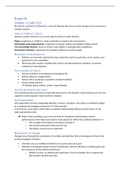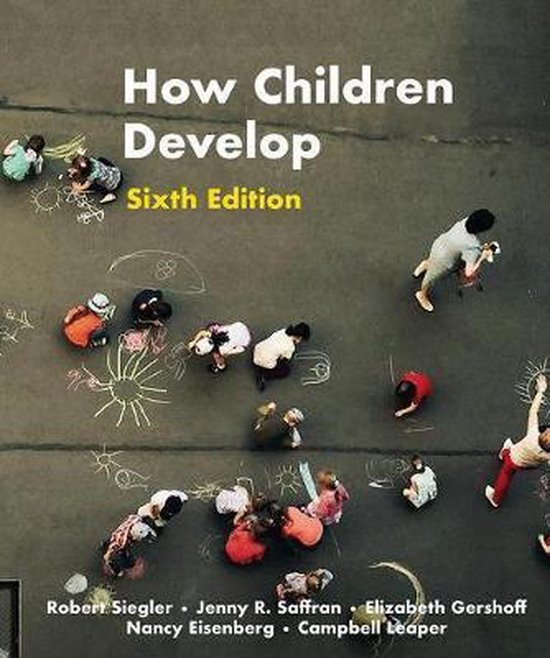Exam B
Chapter 4 (149-153)
Dynamic-systems theories: a class of theories that focus on how change occurs over time in
complex systems
View of children’s nature
Dynamic-systems theories are at some aspects similar to other theories.
Piaget: emphasize on children’s innate motivation to explore the environment
Information-processing theories: emphasize on precise analyses of problem-solving activity
Core-knowledge theories: focus on infant’s and toddler’s surprising early competence
Sociocultural theories: emphasize the formative influencer of other people
Motivators of development
Children are internally motivated to learn about the world around them and to explore and
expand their own capabilities
Observing other people, imitating their actions and attracting their attention are potent
motivators of development
The centrality of action
Actions contribute to development throughout life
Actions influence categorization
Actions affect vocabulary acquisition and generalization
Actions shape memory
thinking shapes actions, actions shape thinking
Central developmental issues
Two developmental issues that are especially prominent in the dynamic-system theories are how the
cognitive system organizes itself and how it changes
Self-organization
Self-organization involves integrating attention, memory, emotions, and actions as needed to adapt
to a continuously changing environment Soft assembly
A-not-B error: many factors other than conceptual understanding influence performance on the
object permanence task.
Rather than providing a pure measurement of conceptual understanding, infant’s
performance on the object-permanence task appears to reflect the combined influence of
o The strength of the habit of reaching to location A
o The memory demands of the current task
o The infants current focus of attention
Mechanisms of change
Changes occur through the mechanisms of variation and selection that are analogous to those that
produce biological evolution
Variation: the use of different behaviours to pursue the same goal
Selection: increasingly frequent choice of behaviours that are effective in meeting goals and
decreasing use of less effective behaviours
o Relative success: as children gain experience, they increasingly rely on approaches
that produce desired outcomes
, o Efficiency
o Novelty: the lure of trying something new
Chapter 5 (176-184)
Reflexes
Grasping reflex: newborns close their fingers around anything that presses against the palm
of their hand
Rooting reflex: turning the head in the direction of the touch and opening of the mouth
Sucking and swallow reflex: oral contact with the nipple
Tonic neck reflex: when head is turned to one side, the arm on that side of the body extends
while the arm and knee on the other side flex
Modern views of motor development
Gesell & McGraw: Infant motor development is governed by brain maturation
Gibson: a particularly important aspect of motor development is affordances the possibilities for
actions offered by objects and situations.
Bornstein: infants who are better able to interact with their environment may have an advantage in
perceptual and cognitive development by being better able to seek out new opportunities for
learning
The expanding world of the infant
Considering some of the ways that motor development affects infants’ experience of the world
Reaching
Pre-reaching movements: clumsy swiping in the general vicinity of objects
Infants’ achievements in motor development pave the way for new opportunities and experiences to
learn. There is interaction between visual development and motor development. Reaching behaviour
has a social component.
Self-locomotion
Self-locomotion: moving around the environment on their own
Younger infants spend much more time looking at faces than older infants do because older inifants
start crawling, so they cannot see the faces of standing adults.
Infants’ proficiency at motor tasks is predicted by the number of days since they first began to
engage in that behaviour
Scale error: treating a miniature object as if it is a much larger one
Grasp errors: child tries to pick up an object from a 2-D presentation
Media errors: a child using interactive technology tries to pass or receive an object through a
screen.
, Chapter 8
What is intelligence?
Intelligence can reasonably be described as three levels of analysis: as one thing, as a few things or as
many things
Intelligence as a single trait
Performance on all intellectual tasks is positively correlated.
G (general intelligence): cognitive processes that influence the ability to think and learn on all
intellectual tasks
G correlates with information processing speed, speed of neural transmission, brain volume and
general information about the world.
Intelligence as a few basic abilities
Fluid intelligence: the ability to think on the spot to solve novel problems. Closely related to: novel
tasks, speed of information processing, working-memory functioning and ability to control attention.
Fluid intelligence peaks around age 20 and slowly declines thereafter. The prefrontal cortex usually is
highly active on measures of fluid intelligence.
Crystallised intelligence: factual knowledge, such as knowledge of word meanings, state capitals,
answers to arithmetic problems etc. It reflects long-term memory for prior experiences and is closely
related to verbal ability. Crystallized intelligence increases steadily from early in life to old age’
A more differentiated view of intelligence proposes that the human intellect in composed of seven
primary mental abilities: word fluency, verbal meaning, reasoning, spatial visualization, numbering,
rote memory and perceptual speed.
Intelligence as numerous cognitive processes
Viewing intelligence as ‘many processes’ allows yet more precise specification of the mechanisms
involved in intelligent behaviour than do approaches that view it as a ‘single trait’ or as ‘several
abilities’.
A proposed resolution
Three-stratum theory of intelligence: an intelligence hierarchy with G on top, 8 moderately general
abilities in the middle and many specific processes at the bottom.
Measuring intelligence
Knowing the facts about intelligence tests and understanding the issues surrounding their use is
crucial to generating informed opinions about these issues
The contents of intelligence tests
Wechsler intelligence scale for children (WISC): widely used test designed to measure the
intelligence of children 6 years and older. The test not only yields an overall score, but also separate
scores on 5 moderately general abilities: verbal comprehension, visual-spatial processing, working
memory, fluid reasoning and processing speed. These abilities reflect skills that are important within
information-processing theories, correlate positively with other aspects of intelligence and are
related to important outcomes.
The intelligence quotient (IQ)
IQ: a quantitative measure of a child’s intelligence, relative to that of other children of the same age.
The IQ-scores fall into a normal distribution, with a mean of 100 and a standard deviation of 15.





